2011 FORD SUPER DUTY fuel
[x] Cancel search: fuelPage 36 of 90
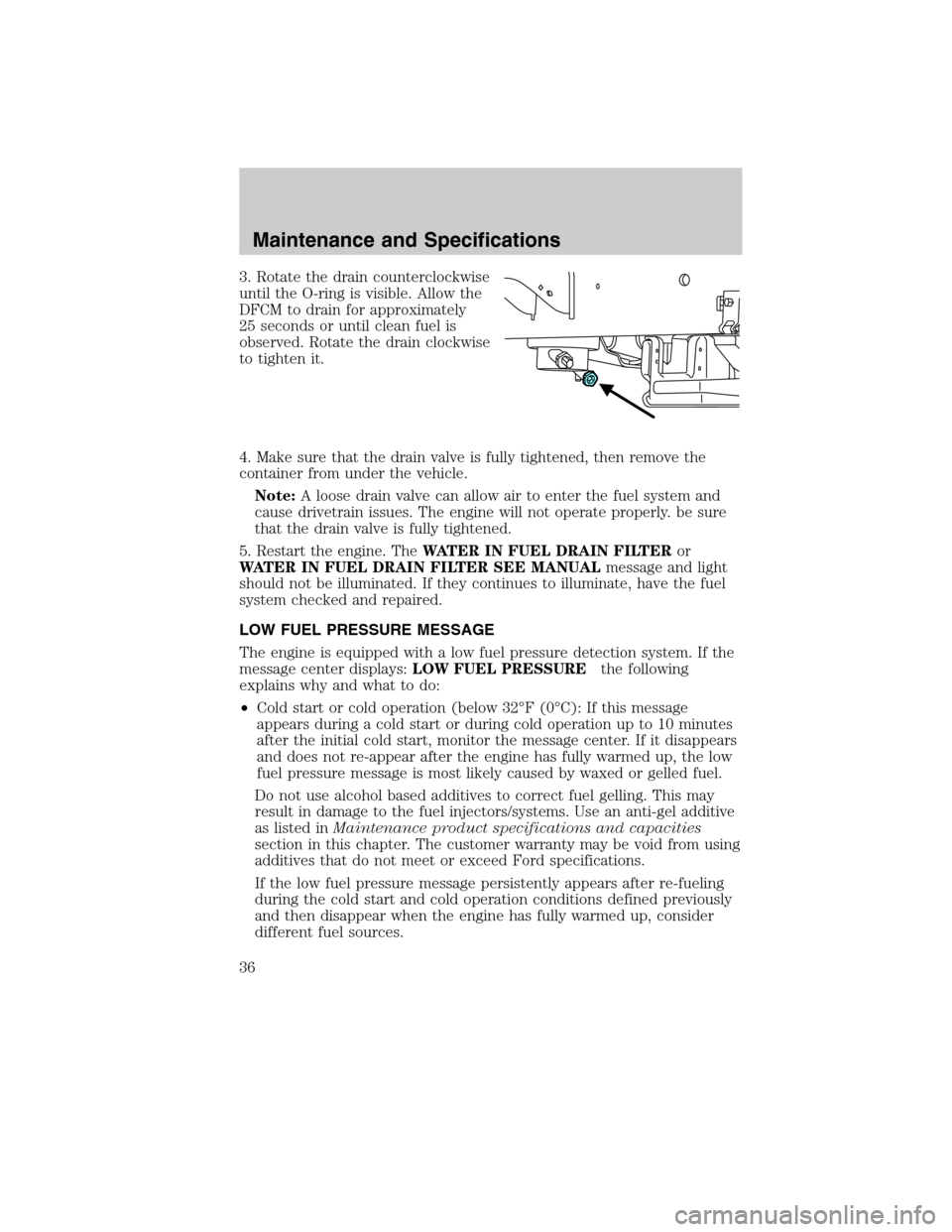
3. Rotate the drain counterclockwise
until the O-ring is visible. Allow the
DFCM to drain for approximately
25 seconds or until clean fuel is
observed. Rotate the drain clockwise
to tighten it.
4. Make sure that the drain valve is fully tightened, then remove the
container from under the vehicle.
Note:A loose drain valve can allow air to enter the fuel system and
cause drivetrain issues. The engine will not operate properly. be sure
that the drain valve is fully tightened.
5. Restart the engine. TheWATER IN FUEL DRAIN FILTERor
WATER IN FUEL DRAIN FILTER SEE MANUALmessage and light
should not be illuminated. If they continues to illuminate, have the fuel
system checked and repaired.
LOW FUEL PRESSURE MESSAGE
The engine is equipped with a low fuel pressure detection system. If the
message center displays:LOW FUEL PRESSUREthe following
explains why and what to do:
•Cold start or cold operation (below 32°F (0°C): If this message
appears during a cold start or during cold operation up to 10 minutes
after the initial cold start, monitor the message center. If it disappears
and does not re-appear after the engine has fully warmed up, the low
fuel pressure message is most likely caused by waxed or gelled fuel.
Do not use alcohol based additives to correct fuel gelling. This may
result in damage to the fuel injectors/systems. Use an anti-gel additive
as listed inMaintenance product specifications and capacities
section in this chapter. The customer warranty may be void from using
additives that do not meet or exceed Ford specifications.
If the low fuel pressure message persistently appears after re-fueling
during the cold start and cold operation conditions defined previously
and then disappear when the engine has fully warmed up, consider
different fuel sources.
Maintenance and Specifications
36
2011 Econoline(eco)
Supplement, 1st Printing
USA(fus)
Page 37 of 90

•Low fuel operation: If the message appears when the vehicle is warm
and during low fuel tank level operation, i.e. the tank level is at or
very near empty, refuel the vehicle and operate the vehicle. If the
message reappears after fueling, see below. If the message does not
come back, the low fuel pressure condition was due to low fuel levels
in the fuel tank.
•Normal operation: If the message appears during normal operation
when the vehicle / engine is fully warm, and fuel level is not low, the
fuel filters must be changed regardless of the maintenance schedule
interval.
•If replacement of the fuel filter does not remedy the low fuel pressure
message during normal operation as defined above, take the vehicle to
your authorized dealer.
CHANGING THE ENGINE-MOUNTED AND DFCM FUEL FILTERS
Your vehicle is equipped with two fuel filters; one is mounted on top of
the driver’s side of the engine and the second filter, inside the DFCM, is
mounted on the frame rail under the driver-side floorboard near the
transmission. Both filters should be replaced at the same time. Regular
fuel filter changes are an important part of engine maintenance; failing to
keep with the scheduled maintenance could lead to engine performance
issues and/or fuel injection system damage. Refer to thescheduled
maintenance informationof this supplement for more information.
Refer toMotorcraft part numberslater in this chapter for the fuel filter
replacement part number. This part number includes filters and seals for
both the engine-mounted and frame-mounted filters.
Removal - DFCM filter
The DFCM filter is located in the lower portion of the DFCM housing.
1. Drain the DFCM. SeeFuel filter/water separatorearlier in this
chapter.
To install the new DFCM filter, seeInstallation – DFCM filterlater in
this section.
Maintenance and Specifications
37
2011 Econoline(eco)
Supplement, 1st Printing
USA(fus)
Page 38 of 90
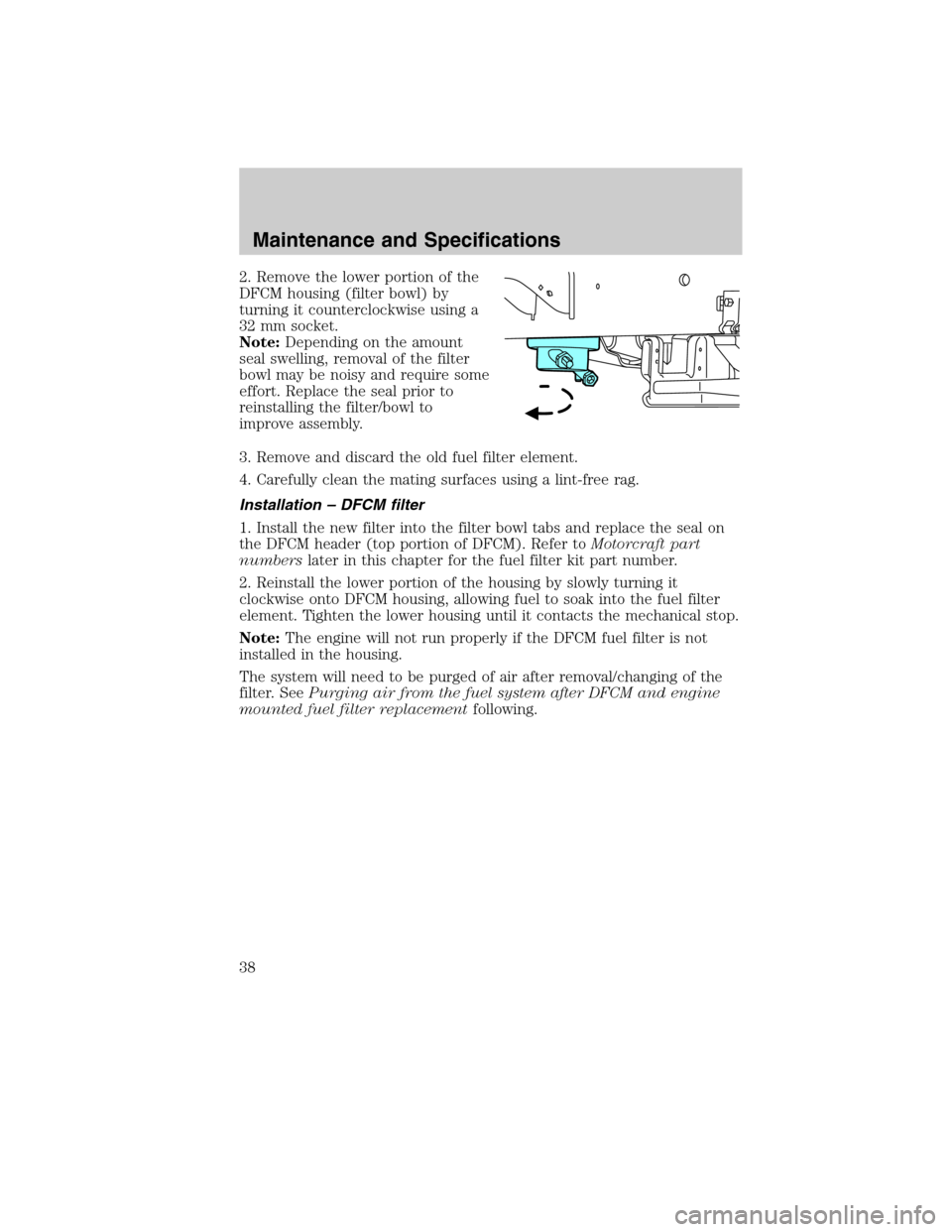
2. Remove the lower portion of the
DFCM housing (filter bowl) by
turning it counterclockwise using a
32 mm socket.
Note:Depending on the amount
seal swelling, removal of the filter
bowl may be noisy and require some
effort. Replace the seal prior to
reinstalling the filter/bowl to
improve assembly.
3. Remove and discard the old fuel filter element.
4. Carefully clean the mating surfaces using a lint-free rag.
Installation – DFCM filter
1. Install the new filter into the filter bowl tabs and replace the seal on
the DFCM header (top portion of DFCM). Refer toMotorcraft part
numberslater in this chapter for the fuel filter kit part number.
2. Reinstall the lower portion of the housing by slowly turning it
clockwise onto DFCM housing, allowing fuel to soak into the fuel filter
element. Tighten the lower housing until it contacts the mechanical stop.
Note:The engine will not run properly if the DFCM fuel filter is not
installed in the housing.
The system will need to be purged of air after removal/changing of the
filter. SeePurging air from the fuel system after DFCM and engine
mounted fuel filter replacementfollowing.
Maintenance and Specifications
38
2011 Econoline(eco)
Supplement, 1st Printing
USA(fus)
Page 39 of 90
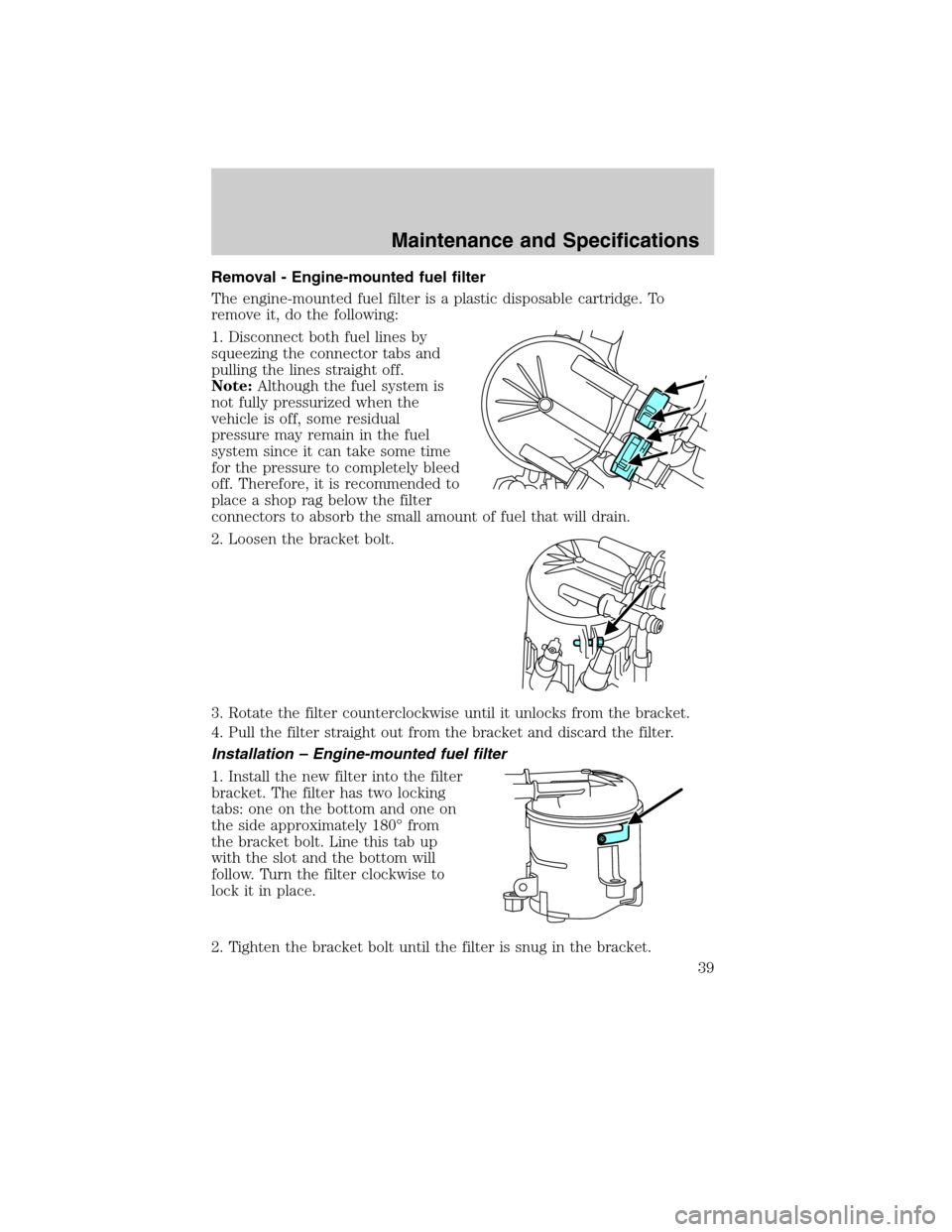
Removal - Engine-mounted fuel filter
The engine-mounted fuel filter is a plastic disposable cartridge. To
remove it, do the following:
1. Disconnect both fuel lines by
squeezing the connector tabs and
pulling the lines straight off.
Note:Although the fuel system is
not fully pressurized when the
vehicle is off, some residual
pressure may remain in the fuel
system since it can take some time
for the pressure to completely bleed
off. Therefore, it is recommended to
place a shop rag below the filter
connectors to absorb the small amount of fuel that will drain.
2. Loosen the bracket bolt.
3. Rotate the filter counterclockwise until it unlocks from the bracket.
4. Pull the filter straight out from the bracket and discard the filter.
Installation – Engine-mounted fuel filter
1. Install the new filter into the filter
bracket. The filter has two locking
tabs: one on the bottom and one on
the side approximately 180° from
the bracket bolt. Line this tab up
with the slot and the bottom will
follow. Turn the filter clockwise to
lock it in place.
2. Tighten the bracket bolt until the filter is snug in the bracket.
Maintenance and Specifications
39
2011 Econoline(eco)
Supplement, 1st Printing
USA(fus)
Page 40 of 90
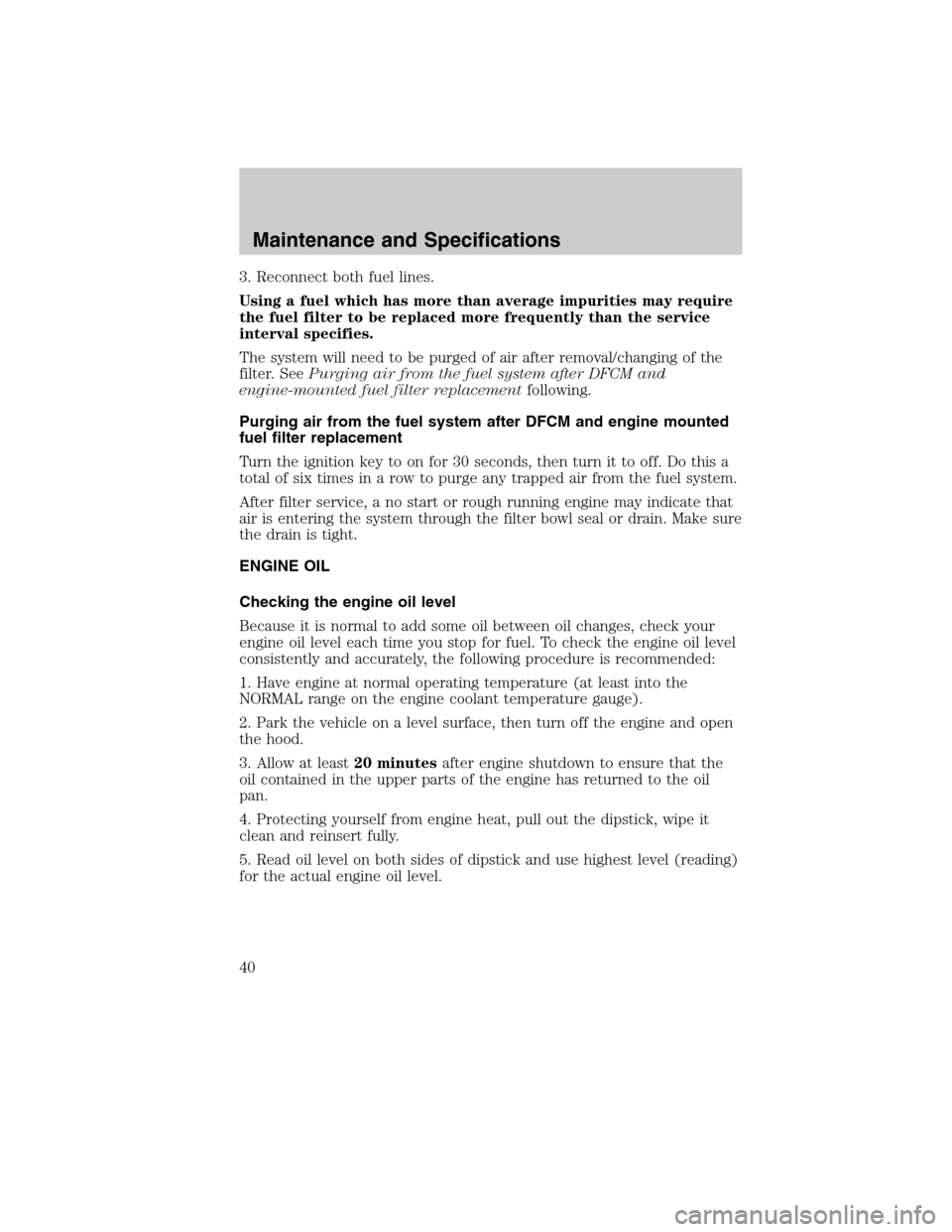
3. Reconnect both fuel lines.
Using a fuel which has more than average impurities may require
the fuel filter to be replaced more frequently than the service
interval specifies.
The system will need to be purged of air after removal/changing of the
filter. SeePurging air from the fuel system after DFCM and
engine-mounted fuel filter replacementfollowing.
Purging air from the fuel system after DFCM and engine mounted
fuel filter replacement
Turn the ignition key to on for 30 seconds, then turn it to off. Do this a
total of six times in a row to purge any trapped air from the fuel system.
After filter service, a no start or rough running engine may indicate that
air is entering the system through the filter bowl seal or drain. Make sure
the drain is tight.
ENGINE OIL
Checking the engine oil level
Because it is normal to add some oil between oil changes, check your
engine oil level each time you stop for fuel. To check the engine oil level
consistently and accurately, the following procedure is recommended:
1. Have engine at normal operating temperature (at least into the
NORMAL range on the engine coolant temperature gauge).
2. Park the vehicle on a level surface, then turn off the engine and open
the hood.
3. Allow at least20 minutesafter engine shutdown to ensure that the
oil contained in the upper parts of the engine has returned to the oil
pan.
4. Protecting yourself from engine heat, pull out the dipstick, wipe it
clean and reinsert fully.
5. Read oil level on both sides of dipstick and use highest level (reading)
for the actual engine oil level.
Maintenance and Specifications
40
2011 Econoline(eco)
Supplement, 1st Printing
USA(fus)
Page 43 of 90

To change the engine oil and oil filter:
1. Unscrew the oil filter and oil pan drain plug and wait for the oil to drain.
Note:The oil pan drain plug only requires 1/4 turn to removal/install. A
3/8 inch socket drive may be used to assist with removal/installation, but be
careful not to over-tighten the plug during installation.
2. Replace the filter.
3. Reinstall the oil pan drain plug.
4. Refill the engine with new oil. For the proper capacity, see
Maintenance product specifications and capacitiesin this chapter.
5. Reset the Intelligent Oil Life Monitor™. SeeMessage centerin the
Instrument Clusterchapter for more information.
WARNING:Do not handle a hot oil filter with bare hands.
WARNING:Continuous contact with used motor oil has caused
cancer in laboratory mice. Protect your skin by washing with
soap and water.
Engine lubrication for severe service operation
The following conditions define severe operation for which engine
operation with SAE 5W-40 API CJ-4 is recommended. Oil and oil filter
change intervals will be determined by the Intelligent Oil Life Monitor™
as noted previously.
•
frequent or extended idling (over 10 minutes per hour of normal driving)
•low-speed operation/stationary use
•if vehicle is operated in sustained ambient temperatures below -10°F
(-23°C) or above 100°F (38°C)
•frequent low-speed operation, consistent heavy traffic less than
25 mph (40 km/h)
•operating in severe dust conditions
•operating the vehicle off road
•towing a trailer over 1,000 miles (1,600 km)
•sustained, high-speed driving at Gross Vehicle Weight Rating
(maximum loaded weight for vehicle operation)
•
use of fuels with sulfur content other than ultra-low sulfur diesel (ULSD)
•use of high-sulfur diesel fuel
Maintenance and Specifications
43
2011 Econoline(eco)
Supplement, 1st Printing
USA(fus)
Page 49 of 90
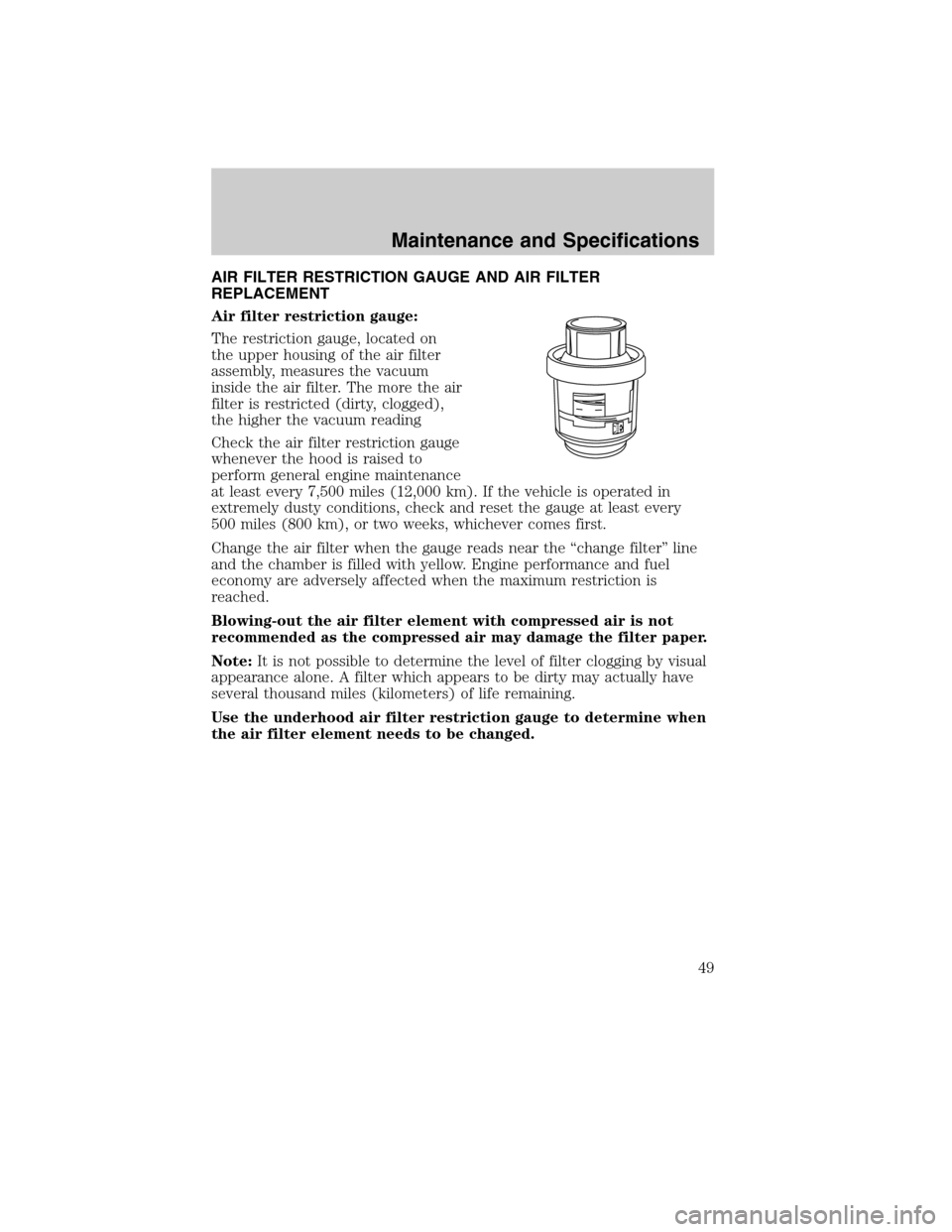
AIR FILTER RESTRICTION GAUGE AND AIR FILTER
REPLACEMENT
Air filter restriction gauge:
The restriction gauge, located on
the upper housing of the air filter
assembly, measures the vacuum
inside the air filter. The more the air
filter is restricted (dirty, clogged),
the higher the vacuum reading
Check the air filter restriction gauge
whenever the hood is raised to
perform general engine maintenance
at least every 7,500 miles (12,000 km). If the vehicle is operated in
extremely dusty conditions, check and reset the gauge at least every
500 miles (800 km), or two weeks, whichever comes first.
Change the air filter when the gauge reads near the “change filter” line
and the chamber is filled with yellow. Engine performance and fuel
economy are adversely affected when the maximum restriction is
reached.
Blowing-out the air filter element with compressed air is not
recommended as the compressed air may damage the filter paper.
Note:It is not possible to determine the level of filter clogging by visual
appearance alone. A filter which appears to be dirty may actually have
several thousand miles (kilometers) of life remaining.
Use the underhood air filter restriction gauge to determine when
the air filter element needs to be changed.
Maintenance and Specifications
49
2011 Econoline(eco)
Supplement, 1st Printing
USA(fus)
Page 56 of 90
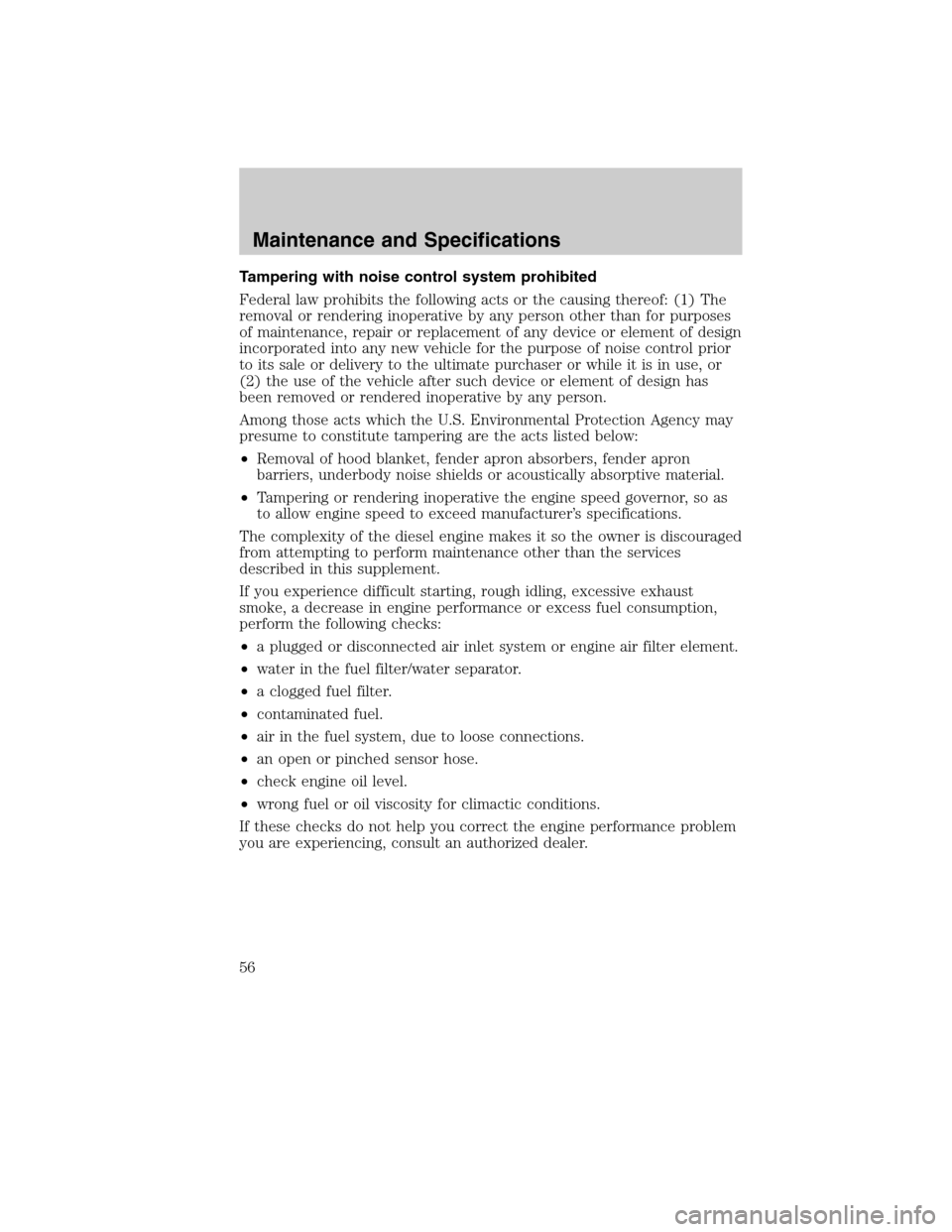
Tampering with noise control system prohibited
Federal law prohibits the following acts or the causing thereof: (1) The
removal or rendering inoperative by any person other than for purposes
of maintenance, repair or replacement of any device or element of design
incorporated into any new vehicle for the purpose of noise control prior
to its sale or delivery to the ultimate purchaser or while it is in use, or
(2) the use of the vehicle after such device or element of design has
been removed or rendered inoperative by any person.
Among those acts which the U.S. Environmental Protection Agency may
presume to constitute tampering are the acts listed below:
•Removal of hood blanket, fender apron absorbers, fender apron
barriers, underbody noise shields or acoustically absorptive material.
•Tampering or rendering inoperative the engine speed governor, so as
to allow engine speed to exceed manufacturer’s specifications.
The complexity of the diesel engine makes it so the owner is discouraged
from attempting to perform maintenance other than the services
described in this supplement.
If you experience difficult starting, rough idling, excessive exhaust
smoke, a decrease in engine performance or excess fuel consumption,
perform the following checks:
•a plugged or disconnected air inlet system or engine air filter element.
•water in the fuel filter/water separator.
•a clogged fuel filter.
•contaminated fuel.
•air in the fuel system, due to loose connections.
•an open or pinched sensor hose.
•check engine oil level.
•wrong fuel or oil viscosity for climactic conditions.
If these checks do not help you correct the engine performance problem
you are experiencing, consult an authorized dealer.
Maintenance and Specifications
56
2011 Econoline(eco)
Supplement, 1st Printing
USA(fus)